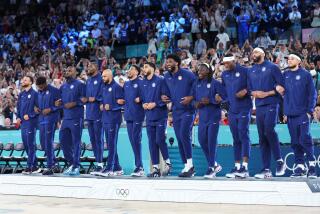U.S. Polishes Off Its 21st Medal
SALT LAKE CITY — U.S. athletes won two more gold medals in speed skating and bobsledding Tuesday, easily setting a U.S. record haul for the Winter Olympics and positioning the U.S. to far surpass its wildest golden dreams.
The unprecedented success of U.S. athletes at these Winter Olympics--reaching 21 medals here Tuesday with gold medals by Derek Parra in speed skating and an unexpected win by U.S. women bobsledders Vonetta Flowers and Jill Bakken--was born out of U.S. failure and embarrassment at the ’88 Games in Calgary.
It was there that U.S. winter athletes won just six medals and only one gold. And it was there that the United States Olympic Committee vowed to move quickly, establishing a special advisory board that became known immediately as the Steinbrenner Commission, named after the flamboyant, no-nonsense owner of the New York Yankees who became its chairman.
Its mission was to do what its chairman was known for doing best: Play hardball. It was no longer enough for athletes to make the Olympic teams, Steinbrenner intoned in February 1989, they needed to bring home the gold.
Over the last 14 years and with many millions of dollars plunged into training, developing a diverse talent pool and financially supporting its athletes, the USOC watched the progress: 11 medals at Albertville in 1992, 13 each in Lillehammer in ’94 and Nagano in ’98.
They became so confident that they predicted “at least 20 medals” here.
“Doggone if it hasn’t happened,” USOC spokesman Mike Moran said Tuesday.
A healthy measure of the U.S. success has come in sports added in recent years to the Olympic program. Seven of the 21 U.S. medals, for instance, were won in snowboarding events; snowboarding debuted at the 1998 Nagano Games.
Three more medals were won in freestyle skiing--either moguls or aerials. Aerials have been part of the program since 1994, moguls since 1992.
Parra, who won the gold in the 1,500 meters in world record time to go with a silver medal last week in the 5,000 meters--the first Latino to medal for the U.S. during a Winter Games--is a poster child for the new U.S. Olympic athlete.
He grew up in San Bernardino, now lives in Orlando, Fla., and was a world-class in-line skater. But he wanted a shot at the Olympics, so he switched to long track speed skating. That transition was eased by a job with Olympic sponsor Home Depot that allowed him to create a work schedule that fit his training schedule and gave him the kind of financial security that most of his U.S. athlete predecessors never had.
When Bakken and Flowers--who organizers said became the first black to win a gold at a Winter Olympics--surprised the competition with their first-place run Tuesday, they brought the ultimate success to a program that was enhanced by $4.6 million in the last four years.
And it all began with the Steinbrenner Commission, which released its report 11 months after it had been given the mandate to figure out a way to fix things. The document, presented to the USOC Executive Board on Feb. 20, 1989, was short and to the point. Its summary said: “A committee recommends tighter management, creative marketing and financial help to athletes.”
The last phrase became the password. Like so many things, Steinbrenner’s group told the USOC that it was all about the money.
Before the new measures pushed by the Steinbrenner Commission, the most any U.S. athlete could make from the USOC was $2,500 a year.
But another poster child for the U.S. success, Clay Ives, is an example of how much has changed.
Born and raised Canadian and a veteran of Canada’s luge teams, Ives carried a U.S. passport--his mother was born in Gila Bend, Ariz.--and didn’t think much about ever using it until he realized he could no longer continue to train and eat on the $7,500 a year he was getting from the Canadian Luge Federation. In desperation, he switched to the U.S. team, where his annual stipend went to about $25,000. Last week, he and teammate Chris Thorp won a bronze medal in doubles luge. For the United States.
Since 1998, U.S. speed skaters have been funded to the tune of $5.4 million, and that’s less than half of the $11.4 million that went to the alpine skiers.
Of the $5.4 million for the speed skaters, $675,600 went in stipends directly to athletes--to help them pay the rent or buy groceries.
The other part of the Steinbrenner document that received the most attention at the time, and is worth revisiting in the wake of 21 medals, was the section that read: “Winning medals is, and should be, a prime goal. It’s important to this country to be among the best.”
So the tone was set in 1989, and it hasn’t slowed. Before the ’96 Summer Games in Atlanta, the USOC made a special allotment to athletes for the year before the Games. They called it Home Team ’96 and earmarked the money for such things as coaches for athletes, equipment or travel expenses to extra competitions.
One of the leaders of that effort was Sandy Baldwin, then the USOC treasurer, now USOC president and recently elected member of the International Olympic Committee.
The funding of the athletes for ’96 was followed by a commitment of $40 million to fund U.S. athletes heading to Sydney for the 2000 Summer Games and for Salt Lake city in 2002. And out of that $40 million, which ended up to be exactly $40,622,955, an $18-million program just for the Salt Lake athletes was created and called Podium 2002.
With that outlay came expectations.
“These were the ‘no excuses’ Games,” said Jim Page, the USOC’s managing director for sport, while he watched yet another U.S. success Tuesday, Joe Pack’s silver in the men’s aerial freestyle skiing competition.
More to Read
Go beyond the scoreboard
Get the latest on L.A.'s teams in the daily Sports Report newsletter.
You may occasionally receive promotional content from the Los Angeles Times.







